Pengertian Teknologi Informasi dan Komunikasi (TIK)
Pengertian TIK:- Menurut Eric Deeson, Harper Collins Publishers, Dictionary of Information Technology, Glasgow,UK,1991
“Information Technology (IT) the handling of information by electric and electronic (and microelectronic) means.”
Here handling includes transfer. Processing, storage and access, IT special concern being the use of hardware and software for these tasks for the benefit of individual people and society as a whole”
Dari penjelasan di atas : kebutuhan manusia didalam mengambil dan memindahkan , mengolah dan memproses informasi dalam konteks social yang menguntungkan diri sendiri dan masyarakat secara keseluruhan. Bagaimana implikasinya agar dapat menguntungkan secara individual dan masyarakat secara keseluruhan tidak didifinisikan secara lebih khusus. - Information Technology in the National Curriculum, England and Wales, 1995
“Information technology (IT) capability is characterized by an ability to use effectively IT tools an information source to analyse, process an present information, and to model, measure an control external events.
This Involve :
· Using information sourcxes and IT tools to solve problems
· Using it tools and information source, sich as computer systems and software packages, to support learning in variety contexts;
· Understanding the implication of IT for working life and society.
Pupils should be given opportunities, where appropriate, to develop and apply their IT capability in their study of National Curriculum subjects.”
Dari penjelasan di atas : nampaknya terdapat acuan kemampuan TIK yang hendak dicapai dan system nilai dalam bekerja pada kehidupan sehari-hari yang hendak dibelajarkan, seperti nilai apa yang perlu dikembangkan dalam suatu system social masyarakat berkenaan dengan kemampuan menggunakan TIK - Menurut Puskur Diknas Indonesia th …..
a. Teknologi Informasi dan Komunikasi (TIK) mencakup dua aspek, yaitu Teknologi Informasi dan Teknologi Komunikasi.
i. Teknologi Informasi adalah meliputi segala hal yang berkaitan dengan proses, penggunaan sebagai alat bantu, manipulasi, dan pengelolaan informasi.ii. Teknologi Komunikasi adalah segala hal yang berkaitan dengan penggunaan alat bantu untuk memproses dan mentransfer data dari perangkat yang satu ke lainnya.
b. Teknologi Informasi dan Teknologi Komunikasi adalah suatu padanan yang tidak terpisahkan yang mengandung pengertian luas tentang segala kegiatan yang terkait dengan pemrosesan, manipulasi, pengelolaan, dan transfer/pemindahan informasi antar media - Menurut anatta sannai, Jakarta Indonesia,
2004
Teknologi Informasi dan komunikasi adalah sebuah media atau alat bantu dalam memperoleh pengetahuan antara seseorang kepada oranglain
Teknologi informasi sampai dengan saat ini berkembang sangat pesat seiring dengan penemuan dan pengembangan ilmu pengetahuan dalam bidang informasi dan komunikasi. Hal tersebut mampu menciptakan peralatan yang mendukung perkembangan teknologi informasi, mulai dari sistem komunikasi sampai dengan alat komunikasi yang searah maupun dua arah (interaktif).
Pada dasarnya peralatan teknologi informasi meliputi 3 perangkat utama yaitu:
A . Sistem Komputer;
B . Jaringan Sistem Komunikasi;
C . Net Tools.
A. Sistem Komputer
Komputer merupakan perangkat elektronika yang mampu menerima, memproses, dan menyimpan data, serta menghasilkan bentuk keluaran berupa teks, gambar, simbol, angka dan suara. Dalam pengoperasian, bentuk, sistem dan fungsinya, komputer terdiri atas 2 (dua) bagian yaitu hardware dan software.
1) Hardware (Perangkat Keras)
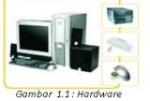 Untuk
memenuhi kebutuhan akan bebagai informasi, manusia senantiasa untuk
mengembangkan perangkat keras untuk mendukungnya. Untuk mengakomodasi
kepentingan ini, manusia menciptakan berbagai peralatan yang menyokong
keinginan tersebut. Perangkat hardware komputer dapat dikelompokkan
menjadi perangkat input (didntaranya : Keyboard, Scanner), perangkat
proses (diantaranya : CPU), perangkat output dan penyimpan data
(diantaranya : Monitor, dan Printer), dan perangkat penyimpan data
(diantaranya : CDROM, Compact Disk, Floppy Disk, Hard disk). Penjelasan
lebih mendalam tentang perangat komputer akan Anda peroleh juga pada
modul 3.
Untuk
memenuhi kebutuhan akan bebagai informasi, manusia senantiasa untuk
mengembangkan perangkat keras untuk mendukungnya. Untuk mengakomodasi
kepentingan ini, manusia menciptakan berbagai peralatan yang menyokong
keinginan tersebut. Perangkat hardware komputer dapat dikelompokkan
menjadi perangkat input (didntaranya : Keyboard, Scanner), perangkat
proses (diantaranya : CPU), perangkat output dan penyimpan data
(diantaranya : Monitor, dan Printer), dan perangkat penyimpan data
(diantaranya : CDROM, Compact Disk, Floppy Disk, Hard disk). Penjelasan
lebih mendalam tentang perangat komputer akan Anda peroleh juga pada
modul 3.a) Keyboard
 Keyboard adalah alat untuk memasukkan data ataupun perintah ke CPU (Central Processing Unit). Keyboard biasanya terdiri dari rangkaian huruf dan angka.
Keyboard adalah alat untuk memasukkan data ataupun perintah ke CPU (Central Processing Unit). Keyboard biasanya terdiri dari rangkaian huruf dan angka.b) Scanner
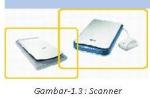 Scanner
merupakan alat bantu untuk memasukkan data berupa gambar/grafik dan
merubahnya ke dalam bentuk digital sehingga dapat diproses dan
digabungkan dengan bentuk data yang berupa teks.
Scanner
merupakan alat bantu untuk memasukkan data berupa gambar/grafik dan
merubahnya ke dalam bentuk digital sehingga dapat diproses dan
digabungkan dengan bentuk data yang berupa teks.c) Central Processing Units
 Certral Processing Units (CPU) adalah
Certral Processing Units (CPU) adalahalat yang berfungsi sebagai pemroses (pengolah) data. CPU merupakan rangkaian sirkuit yang menyimpan instuksi-instruksi pemrosesan, dan penyimpanan data sementara.
d) Monitor
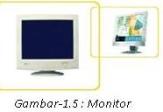 Monitor adalah alat yang mampu menampilkan teks maupun gambar dari data yang diproses dalam CPU.
Monitor adalah alat yang mampu menampilkan teks maupun gambar dari data yang diproses dalam CPU.e) Printer
 Printer adalah alat untuk memproduksi keluaran data (output) berbentuk cetak, baik itu berupa teks maupun gambar/grafik.
Printer adalah alat untuk memproduksi keluaran data (output) berbentuk cetak, baik itu berupa teks maupun gambar/grafik.f) CD Rom
 CD Rom adalah alat tambahan (alat peripheral) yang mampu menyimpan dan menuliskan data dan program melalui media Compact Disk (CD). Alat ini didesain mampu menuliskan dan membaca data atau program melalui sistem Optik.
CD Rom adalah alat tambahan (alat peripheral) yang mampu menyimpan dan menuliskan data dan program melalui media Compact Disk (CD). Alat ini didesain mampu menuliskan dan membaca data atau program melalui sistem Optik.g) Compact Disk (CD)
Compact Disk (CD) merupakan media penyimpanan yang terbuat dari bahan plastik. Proses penyimpanan dan pembacaan data menggunakan sistem optik.
h) Floppy Disk
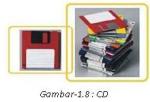 Floppy Disk adalah
alat tambahan untuk menyimpan atau menuliskan data ke dalam disket
maupun sebaliknya. Ukuran yang umum digunakan adalah ukuran 3,5 inchi.
Floppy Disk adalah
alat tambahan untuk menyimpan atau menuliskan data ke dalam disket
maupun sebaliknya. Ukuran yang umum digunakan adalah ukuran 3,5 inchi.i) Hard Disk
 Harddisk adalah alat tambahan untuk menyimpan data dalam kapasitas yang besar yang dilapisi secara magnetis.
Harddisk adalah alat tambahan untuk menyimpan data dalam kapasitas yang besar yang dilapisi secara magnetis.2) Software (Perangkat Lunak)
Software merupakan sebuah program komputer yang berisi sekumpulan instruksi yang dibuat dengan menggunakan bahasa khusus. Progran ini memberi perintah kepada komputer untuk melakukan berbagai pengoperasian/pemrosesan terhadap data yang terdapat dalam program tersebut atau data yang dimasukan oleh pengguna komputer. Singkat kata software merupakan ‘jiwa’ sedangkan hardware berfungsi sebagai ‘tubuh’ dalam sebuah komputer.
Secara umum perangkat lunak dapat diklasifikasi menjadi 2 (dua) kelas yaitu perangkat lunak sistem dan perangkat lunak aplikasi. Pembahasan secara khusus tentang perangkat lunak akan Anda dapatkan pada kesempatan yang lain.
B. Jaringan Sistem Komunikasi
Jaringan komunikasi merupakan sebuah sistem yang mampu menghubungkan dan menggabungkan beberapa titik komunikasi menjadi satu kesatuan yang mampu berinteraksi antara satu dengan lainnya.
1) Telephone
 Telephone merupakan alat komunikasi dua arah yang memungkinkan 2 orang atau lebih untuk bercakap-cakap tanpa terbatas jarak.
Telephone merupakan alat komunikasi dua arah yang memungkinkan 2 orang atau lebih untuk bercakap-cakap tanpa terbatas jarak.2) ISDN
Integrated Service Digital Network (ISDN) merupakan jaringan komunikasi khusus yang menggunakan jaringan telepon yang tidak hanya meproses suara, tapi juga mampu menangani penyimpanan data berupa teks, gambar, video, faksimili, dan lain lain.
3) Facsimile
Facsimile merupakan sebuah alat yang mampu mengirimkan dokumen secara persis sama melalui jaringan telepon.
4) Fiber Optic
Fiber optic merupakan jaringan komunikasi yang mampu mentransmisikan data dalam frekuensi tinggi. Dalam jaringan ini jalur komunikasi tidak menggunakan kawat tembaga tetapi menggunakan cahaya sebagai penghantar datanya.
5) Leased Line
Leased line merupakan jaringan telepon tetap (permanen) yang menghubungkan dua tempat atau lebih. Jaringan ini tidak mempunyai alat pengalih (switching) atau sejenisnya, jaringan ini bekerja diantara tempat-tempat yang dihubungkan tersebut secara spesifik atau yang sudah ditentukan. Jaringan ini dikenal juga dengan sebutan private line.
6) Wireless
Wirekess adalah jaringan komunikasi nir kabel. Jaringan komunikasi yang menggunakan gelombang radio/frekuensi tertentu yang berfungsi sebagai penghantar informasi. Jaringan komunikasi ini menggunakan alat pemancar, penguat , dan penerima gelombang yang berisi data tersebut.
7) Jaringan Komunikasi dengan Satelit
Jaringan komunikasi tanpa kabel yang menggunakan satelit yang berfungsi sebagai pemancar, penerima dan penguat. Sistem komunikasi ini menggunakan gelombang sebagai penghantar datanya
8) Antena, TV dan Radio, Seluler
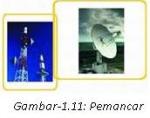 Antena merupakan alat yang digunakan untuk memancarkan dan menerima komunikasi radio.
Antena merupakan alat yang digunakan untuk memancarkan dan menerima komunikasi radio.TV dan Radio merupakan alat penyampaian informasi (mass media) yang menggunakan gelombang sebagai penghantar sinyal suara dan gambar.
9) Komunikasi Seluler
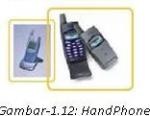 Komunikasi
seluler merupakan komunikasi yang menggunakan transmisi radio untuk
mengirimkan sinyal informasi, alat tersebut lebih dikenal dengan nama Hand Phone.
Komunikasi
seluler merupakan komunikasi yang menggunakan transmisi radio untuk
mengirimkan sinyal informasi, alat tersebut lebih dikenal dengan nama Hand Phone.C. Net tools
Berbagai macam cara digunakan manusia untuk mempermudah dan menjaga kualitas koneksi melalui dunia internet. Sejak saat itulah alat- alat yang menyokong kemampuan jaringan (net tools) berkembang pesat. Sistem jaringan yang tadinya hanya digunakan oleh kalangan terbatas sekarang sudah sangat merakyat bahkan sampai ke tingkat rumah tangga.
1) Server
Sebuah komputer yang bekerja sebagai penyedia data, penyedia software dan penyimpanan data adalah server. Bahkan sebuah server mampu mengatur jalur informasi dalam jaringan yang diaturnya.
2) Client
Client adalah sebuah pesonal computer (PC) dalam sebuah jaringan komunikasi yang mempunyai kemampuan memproses data dan mampu meminta informasi kepada server.
3) Router
Router adalah alat yang digunakan dalam jaringan yang mampu mengirimkan data kepada jaringan lainnya melalui jalur yang lebih cepat, tepat dan efisien.
4) Modem
Modulator/Demodulator adalah alat yang memungkinkan PC, Mini Computer, atau Mainframe untuk menerima dan mengirim data dalam bentuk digital melalui saluran telephon.
Tips
dan trik menggunakan MS Word
Proses
Turn Off Komputer anda lama ? Simak tips berikut untuk mengatasi
masalah tersebut tanpa menggunakan software Utility.
- Klik tombol "Start | Run"
- Ketik : Regedit
- Cari key : HKEY_CURRENT_USER\Control Panel\Desktop
- Dobel Klik pada nilai : HungAppTimeOut
- Rubah nilainya menjadi 4000, nilai sebelumnya kemungkinan 5000 atau 20000.
- Langkah selanjutnya cari key : HKEY_LOCAL_MACHINE\System\CurrentControlSet\Control\ Dobel Klik pada : WaitToKillServiceTimeOut
Sekarang tutup jendela regedit dan Matikan komputer Anda untuk melihat perubahan yang dihasilkan.
Selamat Mencoba.
Keyboard Shorcut Windows XP
CTRL+X
(Cut)
CTRL+V (Paste)
CTRL+Z (Undo)
DELETE (Delete)
SHIFT+DELETE (Delete the selected item permanently without placing the item in the Recycle Bin)
CTRL while dragging an item (Copy the selected item)
CTRL+SHIFT while dragging an item (Create a shortcut to the selected item)
F2 key (Rename the selected item)
CTRL+RIGHT ARROW (Move the insertion point to the beginning of the next word)
CTRL+LEFT ARROW (Move the insertion point to the beginning of the previous word)
CTRL+DOWN ARROW (Move the insertion point to the beginning of the next paragraph)
CTRL+UP ARROW (Move the insertion point to the beginning of the previous paragraph)
CTRL+SHIFT with any of the arrow keys (Highlight a block of text)
SHIFT with any of the arrow keys (Select more than one item in a window or on the desktop, or select text in a document)
CTRL+A (Select all)
F3 key (Search for a file or a folder)
ALT+ENTER (View the properties for the selected item)
ALT+F4 (Close the active item, or quit the active program)
ALT+ENTER (Display the properties of the selected object)
ALT+SPACEBAR (Open the shortcut menu for the active window)
CTRL+F4 (Close the active document in programs that enable you to have multiple documents open simultaneously)
ALT+TAB (Switch between the open items)
ALT+ESC (Cycle through items in the order that they had been opened)
F6 key (Cycle through the screen elements in a window or on the desktop)
F4 key (Display the Address bar list in My Computer or Windows Explorer)
SHIFT+F10 (Display the shortcut menu for the selected item)
ALT+SPACEBAR (Display the System menu for the active window)
CTRL+ESC (Display the Start menu)
ALT+Underlined letter in a menu name (Display the corresponding menu)
Underlined letter in a command name on an open menu (Perform the corresponding command)
F10 key (Activate the menu bar in the active program)
RIGHT ARROW (Open the next menu to the right, or open a submenu)
LEFT ARROW (Open the next menu to the left, or close a submenu)
F5 key (Update the active window)
BACKSPACE (View the folder one level up in My Computer or Windows Explorer)
ESC (Cancel the current task)
SHIFT when you insert a CD-ROM into the CD-ROM drive (Prevent the CD-ROM from automatically playing)
Dialog Box Keyboard Shortcuts
CTRL+TAB (Move forward through the tabs)
CTRL+SHIFT+TAB (Move backward through the tabs)
TAB (Move forward through the options)
SHIFT+TAB (Move backward through the options)
ALT+Underlined letter (Perform the corresponding command or select the corresponding option)
ENTER (Perform the command for the active option or button)
SPACEBAR (Select or clear the check box if the active option is a check box)
Arrow keys (Select a button if the active option is a group of option buttons)
F1 key (Display Help)
F4 key (Display the items in the active list)
BACKSPACE (Open a folder one level up if a folder is selected in the Save As or Open dialog box)
micrsoft Natural Keyboard Shortcuts
Windows Logo (Display or hide the Start menu)
Windows Logo+BREAK (Display the System Properties dialog box)
Windows Logo+D (Display the desktop)
Windows Logo+M (Minimize all of the windows)
Windows Logo+SHIFT+M (Restore the minimized windows)
Windows Logo+E (Open My Computer)
Windows Logo+F (Search for a file or a folder)
CTRL+Windows Logo+F (Search for computers)
Windows Logo+F1 (Display Windows Help)
Windows Logo+ L (Lock the keyboard)
Windows Logo+R (Open the Run dialog box)
Windows Logo+U (Open Utility Manager)Accessibility Keyboard Shortcuts
Right SHIFT for eight seconds (Switch FilterKeys either on or off)
Left ALT+left SHIFT+PRINT SCREEN (Switch High Contrast either on or off)
Left ALT+left SHIFT+NUM LOCK (Switch the MouseKeys either on or off)
SHIFT five times (Switch the StickyKeys either on or off)
NUM LOCK for five seconds (Switch the ToggleKeys either on or off)
Windows Logo +U (Open Utility Manager)
Windows Explorer Keyboard Shortcuts
END (Display the bottom of the active window)
HOME (Display the top of the active window)
NUM LOCK+Asterisk sign (*) (Display all of the subfolders that are under the selected folder)
NUM LOCK+Plus sign (+) (Display the contents of the selected folder)
NUM LOCK+Minus sign (-) (Collapse the selected folder)
LEFT ARROW (Collapse the current selection if it is expanded, or select the parent folder)
RIGHT ARROW (Display the current selection if it is collapsed, or select the first subfolder)Shortcut Keys for Character Map
After you double-click a character on the grid of characters, you can move through the grid by using the keyboard shortcuts:
RIGHT ARROW (Move to the right or to the beginning of the next line)
LEFT ARROW (Move to the left or to the end of the previous line)
UP ARROW (Move up one row)
DOWN ARROW (Move down one row)
PAGE UP (Move up one screen at a time)
PAGE DOWN (Move down one screen at a time)
HOME (Move to the beginning of the line)
END (Move to the end of the line)
CTRL+HOME (Move to the first character)
CTRL+END (Move to the last character)
SPACEBAR (Switch between Enlarged and Normal mode when a character is selected)
micrsoft Management Console (MMC) Main Window Keyboard Shortcuts
CTRL+O (Open a saved console)
CTRL+N (Open a new console)
CTRL+S (Save the open console)
CTRL+M (Add or remove a console item)
CTRL+W (Open a new window)
F5 key (Update the content of all console windows)
ALT+SPACEBAR (Display the MMC window menu)
ALT+F4 (Close the console)
ALT+A (Display the Action menu)
ALT+V (Display the View menu)
ALT+F (Display the File menu)
ALT+O (Display the Favorites menu)
MMC Console Window Keyboard Shortcuts
CTRL+P (Print the current page or active pane)
ALT+Minus sign (-) (Display the window menu for the active console window)
SHIFT+F10 (Display the Action shortcut menu for the selected item)
F1 key (Open the Help topic, if any, for the selected item)
F5 key (Update the content of all console windows)
CTRL+F10 (Maximize the active console window)
CTRL+F5 (Restore the active console window)
ALT+ENTER (Display the Properties dialog box, if any, for the selected item)
F2 key (Rename the selected item)
CTRL+F4 (Close the active console window. When a console has only one console window, this shortcut closes the console)Remote Desktop Connection Navigation
CTRL+ALT+END (Open the micrsoft Windows NT Security dialog box)
ALT+PAGE UP (Switch between programs from left to right)
ALT+PAGE DOWN (Switch between programs from right to left)
ALT+INSERT (Cycle through the programs in most recently used order)
ALT+HOME (Display the Start menu)
CTRL+ALT+BREAK (Switch the client computer between a window and a full screen)
ALT+DELETE (Display the Windows menu)
CTRL+ALT+Minus sign (-) (Place a snapshot of the active window in the client on the Terminal server clipboard and provide the same functionality as pressing PRINT SCREEN on a local computer.)
CTRL+ALT+Plus sign (+) (Place a snapshot of the entire client window area on the Terminal server clipboard and provide the same functionality as pressing ALT+PRINT SCREEN on a local computer.)
m*cro$oft Internet Explorer Navigation
CTRL+B (Open the Organize Favorites dialog box)
CTRL+E (Open the Search bar)
CTRL+F (Start the Find utility)
CTRL+H (Open the History bar)
CTRL+I (Open the Favorites bar)
CTRL+L (Open the Open dialog box)
CTRL+N (Start another instance of the browser with the same Web address)
CTRL+O (Open the Open dialog box, the same as CTRL+L)
CTRL+P (Open the Print dialog box)
CTRL+R (Update the current Web page)
CTRL+W (Close the current window
CTRL+V (Paste)
CTRL+Z (Undo)
DELETE (Delete)
SHIFT+DELETE (Delete the selected item permanently without placing the item in the Recycle Bin)
CTRL while dragging an item (Copy the selected item)
CTRL+SHIFT while dragging an item (Create a shortcut to the selected item)
F2 key (Rename the selected item)
CTRL+RIGHT ARROW (Move the insertion point to the beginning of the next word)
CTRL+LEFT ARROW (Move the insertion point to the beginning of the previous word)
CTRL+DOWN ARROW (Move the insertion point to the beginning of the next paragraph)
CTRL+UP ARROW (Move the insertion point to the beginning of the previous paragraph)
CTRL+SHIFT with any of the arrow keys (Highlight a block of text)
SHIFT with any of the arrow keys (Select more than one item in a window or on the desktop, or select text in a document)
CTRL+A (Select all)
F3 key (Search for a file or a folder)
ALT+ENTER (View the properties for the selected item)
ALT+F4 (Close the active item, or quit the active program)
ALT+ENTER (Display the properties of the selected object)
ALT+SPACEBAR (Open the shortcut menu for the active window)
CTRL+F4 (Close the active document in programs that enable you to have multiple documents open simultaneously)
ALT+TAB (Switch between the open items)
ALT+ESC (Cycle through items in the order that they had been opened)
F6 key (Cycle through the screen elements in a window or on the desktop)
F4 key (Display the Address bar list in My Computer or Windows Explorer)
SHIFT+F10 (Display the shortcut menu for the selected item)
ALT+SPACEBAR (Display the System menu for the active window)
CTRL+ESC (Display the Start menu)
ALT+Underlined letter in a menu name (Display the corresponding menu)
Underlined letter in a command name on an open menu (Perform the corresponding command)
F10 key (Activate the menu bar in the active program)
RIGHT ARROW (Open the next menu to the right, or open a submenu)
LEFT ARROW (Open the next menu to the left, or close a submenu)
F5 key (Update the active window)
BACKSPACE (View the folder one level up in My Computer or Windows Explorer)
ESC (Cancel the current task)
SHIFT when you insert a CD-ROM into the CD-ROM drive (Prevent the CD-ROM from automatically playing)
Dialog Box Keyboard Shortcuts
CTRL+TAB (Move forward through the tabs)
CTRL+SHIFT+TAB (Move backward through the tabs)
TAB (Move forward through the options)
SHIFT+TAB (Move backward through the options)
ALT+Underlined letter (Perform the corresponding command or select the corresponding option)
ENTER (Perform the command for the active option or button)
SPACEBAR (Select or clear the check box if the active option is a check box)
Arrow keys (Select a button if the active option is a group of option buttons)
F1 key (Display Help)
F4 key (Display the items in the active list)
BACKSPACE (Open a folder one level up if a folder is selected in the Save As or Open dialog box)
micrsoft Natural Keyboard Shortcuts
Windows Logo (Display or hide the Start menu)
Windows Logo+BREAK (Display the System Properties dialog box)
Windows Logo+D (Display the desktop)
Windows Logo+M (Minimize all of the windows)
Windows Logo+SHIFT+M (Restore the minimized windows)
Windows Logo+E (Open My Computer)
Windows Logo+F (Search for a file or a folder)
CTRL+Windows Logo+F (Search for computers)
Windows Logo+F1 (Display Windows Help)
Windows Logo+ L (Lock the keyboard)
Windows Logo+R (Open the Run dialog box)
Windows Logo+U (Open Utility Manager)Accessibility Keyboard Shortcuts
Right SHIFT for eight seconds (Switch FilterKeys either on or off)
Left ALT+left SHIFT+PRINT SCREEN (Switch High Contrast either on or off)
Left ALT+left SHIFT+NUM LOCK (Switch the MouseKeys either on or off)
SHIFT five times (Switch the StickyKeys either on or off)
NUM LOCK for five seconds (Switch the ToggleKeys either on or off)
Windows Logo +U (Open Utility Manager)
Windows Explorer Keyboard Shortcuts
END (Display the bottom of the active window)
HOME (Display the top of the active window)
NUM LOCK+Asterisk sign (*) (Display all of the subfolders that are under the selected folder)
NUM LOCK+Plus sign (+) (Display the contents of the selected folder)
NUM LOCK+Minus sign (-) (Collapse the selected folder)
LEFT ARROW (Collapse the current selection if it is expanded, or select the parent folder)
RIGHT ARROW (Display the current selection if it is collapsed, or select the first subfolder)Shortcut Keys for Character Map
After you double-click a character on the grid of characters, you can move through the grid by using the keyboard shortcuts:
RIGHT ARROW (Move to the right or to the beginning of the next line)
LEFT ARROW (Move to the left or to the end of the previous line)
UP ARROW (Move up one row)
DOWN ARROW (Move down one row)
PAGE UP (Move up one screen at a time)
PAGE DOWN (Move down one screen at a time)
HOME (Move to the beginning of the line)
END (Move to the end of the line)
CTRL+HOME (Move to the first character)
CTRL+END (Move to the last character)
SPACEBAR (Switch between Enlarged and Normal mode when a character is selected)
micrsoft Management Console (MMC) Main Window Keyboard Shortcuts
CTRL+O (Open a saved console)
CTRL+N (Open a new console)
CTRL+S (Save the open console)
CTRL+M (Add or remove a console item)
CTRL+W (Open a new window)
F5 key (Update the content of all console windows)
ALT+SPACEBAR (Display the MMC window menu)
ALT+F4 (Close the console)
ALT+A (Display the Action menu)
ALT+V (Display the View menu)
ALT+F (Display the File menu)
ALT+O (Display the Favorites menu)
MMC Console Window Keyboard Shortcuts
CTRL+P (Print the current page or active pane)
ALT+Minus sign (-) (Display the window menu for the active console window)
SHIFT+F10 (Display the Action shortcut menu for the selected item)
F1 key (Open the Help topic, if any, for the selected item)
F5 key (Update the content of all console windows)
CTRL+F10 (Maximize the active console window)
CTRL+F5 (Restore the active console window)
ALT+ENTER (Display the Properties dialog box, if any, for the selected item)
F2 key (Rename the selected item)
CTRL+F4 (Close the active console window. When a console has only one console window, this shortcut closes the console)Remote Desktop Connection Navigation
CTRL+ALT+END (Open the micrsoft Windows NT Security dialog box)
ALT+PAGE UP (Switch between programs from left to right)
ALT+PAGE DOWN (Switch between programs from right to left)
ALT+INSERT (Cycle through the programs in most recently used order)
ALT+HOME (Display the Start menu)
CTRL+ALT+BREAK (Switch the client computer between a window and a full screen)
ALT+DELETE (Display the Windows menu)
CTRL+ALT+Minus sign (-) (Place a snapshot of the active window in the client on the Terminal server clipboard and provide the same functionality as pressing PRINT SCREEN on a local computer.)
CTRL+ALT+Plus sign (+) (Place a snapshot of the entire client window area on the Terminal server clipboard and provide the same functionality as pressing ALT+PRINT SCREEN on a local computer.)
m*cro$oft Internet Explorer Navigation
CTRL+B (Open the Organize Favorites dialog box)
CTRL+E (Open the Search bar)
CTRL+F (Start the Find utility)
CTRL+H (Open the History bar)
CTRL+I (Open the Favorites bar)
CTRL+L (Open the Open dialog box)
CTRL+N (Start another instance of the browser with the same Web address)
CTRL+O (Open the Open dialog box, the same as CTRL+L)
CTRL+P (Open the Print dialog box)
CTRL+R (Update the current Web page)
CTRL+W (Close the current window
Setting ini bertujuan untuk membebaskan 20% bandwith yang digunakan windows dan menaikkan kapasitas bandwith kita 20%. Trik ini berjalan baik pada Windows 2000.
Selamat mencoba...
Tips
& Trik Microsoft Excel
Rumus Excel VLOOKUP
Syntax dari fungsi microsoft excel ini adalah : VLOOKUP (lookup_value, table_array, col_index_num, range_lookup)Rumus Excel VLOOKUP dipakai untuk mencari nilai dalam kolom pertama dari tabel dan mengembalikan nilai dalam baris yang sama dari kolom lain dalam tabel. Supaya lebih jelas, kita pakai fungsi Microsoft Excel VLOOKUP dalam contoh berikut.
Toko Saribusana memiliki tabel Daftar Barang sbb. :

Kemudian, saya diminta membuat tabel hasil penjualan bulan Juli 2011 seperti berikut :

Untuk mengisi kolom Keterangan, saya akan ambil dari Daftar Barang Toko Saribusana berdasarkan Kode yang ada, maka rumus Excel nya adalah
=VLOOKUP(B12,$B$3:$E$6,2,FALSE)
B12 : Kode Barang di B12 adalah acuan yang dipakai untuk mengambil data di tabel Daftar Barang.
$B$3:$E$6 : range tabel yang akan kita ambil datanya, dalam hal ini adalah tabel Daftar Barang tanpa mengikutsertakan judul kolom. Dan, jangan lupa gunakan $ sebab range tabel adalah absolut.
2 : kolom ke-2 yaitu kolom Keterangan di range tabel adalah kolom yang akan kita ambil datanya. Kolom ke-1 selalu dimulai dari kolom paling kiri.
Singkatnya, kita menyuruh Excel melihat Kode di cel B12 lalu cari di range tabel Daftar Barang sesuai Kode yang sama, setelah itu ambil nilai di kolom Keterangannya dan isikan di tabel Hasil Penjualan. Hasilnya :

Demikian juga untuk mengisi kolom Harga Penjualan di cel E12, dengan memperhatikan bahwa Harga Penjualan = Harga Pokok * (1+Markup), maka , rumus Excel nya adalah
=VLOOKUP(B12,$B$3:$E$6,3,FALSE)*(1+VLOOKUP(B12,$B$3:$E$6,4,FALSE))
Di fungsi Microsoft Excel tersebut, kita menyuruh Excel melihat Kode di B12 lalu cari kode yang sama di tabel Daftar Barang, setelah itu ambil Harga Pokoknya dan kalikan Harga Pokok dengan (1+Markup). Nilai Markup diambil dengan cara yang sama dengan cara mengambil nilai Harga Pokok. Maka kita mendapatkan Harga Penjualan untuk Kode di B12.
Oke, silakan mencoba dulu dan mengutak atik fungsi Microsoft Excel VLOOKUP. Semoga mengerti.
Oh, ya, V di VLOOKUP singkatan dari vertikal. Penggunaan VLOOKUP (bukan HLOOKUP) ketika nilai-nilai acuan Anda berada dalam kolom di sebelah kiri tabel data dan Anda mengambil data lain di sebelah kanannya. Gunakan fungsi microsoft excel HLOOKUP ketika nilai-nilai acuan Anda berada dalam baris di sebelah atas tabel data dan Anda ingin mengambil data-data di baris bawahnya.
Rumus Excel IF
Syntax dari fungsi microsoft excel ini adalah : IF(logical_test,value_if_true,value_if_false)Maka dengan menggunakan fungsi microsoft excel IF, kita memberikan :
- suatu kondisi kepada Excel, lalu
- jika kondisi itu terpenuhi maka lakukan A,
- jika tidak terpenuhi maka lakukan B.

Rumus excel di sel G12 adalah
=IF(D12>300,IF(D12>500,”Laku Keras”,”Kurang Laku”),”Ga Laku”)
Saya meminta Excel untuk mengecek :
- Apakah unit terjual di D12 lebih dari 300 =IF(D12>300
- Jika ya maka cek lagi apakah D12 lebih dari 500, IF(D12>500
- Jika ya maka Laku Keras, “Laku Keras”
- jika tidak maka Kurang Laku. “Kurang Laku”
- jika tidak berarti barang Ga Laku. “Ga Laku”
Sekarang kita akan mencoba fungsi microsoft excel yang berhubungan dengan tanggal.
Fungsi Microsoft Excel Date and Time
Kedua fungsi microsoft excel ini sering juga dipakai dalam mengolah data di Excel.
Langsung saja, di atas adalah tabel Daftar Siswa Tercepat dalam Ujian IPA dari tiap kelas. Petugas administrasi memasukkan data tanggal, bulan, tahun dalam kolom-kolom terpisah supaya lebih cepat dan mudah. Nah, tugas saya mencari siapa yang tercepat dari kelima kontestan tersebut.
Pertama, saya satukan dulu tanggal, bulan dan tahun menjadi satu di sel C12 dengan fungsi microsoft excel :
=DATE(E3,D3,C3)
Fungsi microsoft excel ini mengambil data di sel E3,D3,C3 dan menjadikannya tanggal.
Lalu satukan juga jam, menit, dan detik tiap siswa di sel D12 dengan rumus :
=TIME(F3,G3,H3)
Rumus ini mengambil data di sel E3,D3,C3 dan menjadikannya waktu, untuk format time yang Anda ingini, ubah dalam menu Format Cells (klik kanan di sel, pilih Format Cells, pilih Time, pilih format yang Anda mau).
Baru saya cari siswa tercepat di sel E12 dengan fungsi microsoft excel :
=RANK(D12,$D$12:$D$16,1)
Fungsi Rank mencari urutan dalam suatu range, lalu Anda bisa pilih mau Ascending atau Descending. Hasilnya adalah tabel berikut, selamat buat Cassey, kamu tercepat!

Tidak ada komentar:
Posting Komentar